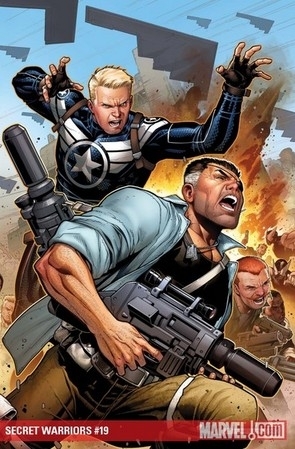Comics /
Comic Reviews /
Marvel Comics
Secret Warriors #19
By Zak Edwards
August 29, 2010 - 17:51
Secret Warriors is one of those books which must be better consumed in trade format. The series, which has been building a tangled web of stories and details from the beginning, is entirely too complex to fully understand without a returning to the beginning every month, or at least fairly frequently. I will be rereading Secret Warriors in its entirety sometime soon, not right away, but sometime soon, just to remember all the details and see if the series does make sense without a “Nick Fury is holding everything back” clause. Jonathan Hickman has proven to be quite the forward thinking creator in this, coming from his independent smaller mini-series and his short story take on Fantastic Four and launching straight into a longer narrative without skipping a beat, a move I’m sure was no small feat on his behalf. Unfortunately, solicitations for this series suggest a closing is coming soon, perhaps early next year, meaning maybe the long goal reaches of this series will inevitably go the route of television shows given a four episode warning to wrap everything up (Dollhouse or Arrested Development, anyone?). But for now, the book is quite the ride, even if I don’t understand everything that’s going on.
 |
But the book does suffer some of the faults I am beginning to see as common motifs in Hickman’s writings, a trend which can be traced in more extreme ways throughout the career of the popular but ultimately problematic Frank Miller. Frank Miller, as many will attest to, is a man whose political leanings have led him down a path of work suffering from a myriad of misogynistic and melodramatic moments, not to mention a generally downward spiral in quality. His famous Dark Knight Returns suffers from these leanings to a minor extent, all women over the age of about thirty are either prostituting their daughters (Selina Kyle) or contributing poorly contrived opinions to the ludicrous ‘infotainment’ on the television segments (Lana Lang), but these problems have increased tenfold by the time one begins The Dark Knight Strikes Again. Hickman, in a similar vein, has some views which are gradually making his work much more problematic as he goes along. For those of you have read my sporadic reviews of his run on Fantastic Four, specifically issue #572, you'll know I have problems with Hickman’s nostalgia. Nostalgia again becomes a problem in this book, as the Howling Commandos remember the great fights they’ve had over a story of a current fight against one of the many antagonists of the story. The juxtaposition of stories is strange, discussing the horrors of war in many different forms of cliche while presenting a new battle complete with acts of bravery and stupidity (often overlapping) which only reinforces the gung-ho glory hound identity of the soldier. Of course, Steve Rogers (of Captain America fame) shows up to make sure no one thinks this of Fury at the end, and I do say I agree with him on this, but the complete disconnect from the actual horrors of war and the destruction they cause on multiple levels becomes tiresome by the end of the issue. Indeed, this entire “The Last Ride of the Howling Commandos” story has been giving into a general discourse of how cool war should be and the hyper-masculine awesome guys it creates, as if post-traumatic stress disorder only effects the weak and being a good and violent soldier who takes extreme risks is an acceptable part of masculine identity. The only character who seems to be exempt from this is the arguable protagonist, Nick Fury, who is the only one who seems genuinely disturbed by the wars and violence he has participated in over the years, as explained quite explicitly by Steve Rogers at the end of the issue. This speech is, somewhat strangely, the best part of the issue, moving the issue past the problematic nostalgia and instead focusing on the disturbing non-teleological nature of Fury’s mission to keep humanity and its rights protected from mostly itself. It is through Rogers’ acknowledgment of the disgust Fury feels that keeps this issue from falling into some major trappings it has been susceptible to for this entire arc.
As for the art, Alessandro Vitti has been doing a wonderful job so far. In an issue which needs to be simultaneously quite entertaining on the action front and attentive to the expressions of the characters, Vitti hits both seemingly quite easily. The colouring is of exceptional quality, the palette of slightly washed out and flat colours make the book quite nice to look at while tying into the themes of nostalgia Hickman writes about. There are a few panels which are simply a BOOM! sound effect with a picture behind it which detract from otherwise fairly interesting art, I feel these panels bring the book too close to the normal action genre, which is understandable but still feeling like a simplification of the series, which is relying more on intrigue than wanton violence. Vitti’s ability to mix scenes together on a page without a reliance on captions keeps the pages focused on much more important things and eases the reading. Without this ability, this book would be not only confusing, but enormously frustrating. Vitti’s art has been enjoyable and communicative with an obvious eye for flow and panelling.
Grade: B- Hickman is starting to fall into some problematic trends, but is still creating an enjoyable book which looks great.
Last Updated: January 17, 2025 - 08:20
